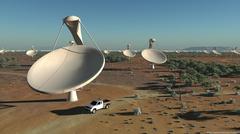URL: https://www.desy.de/news/news_search/index_eng.html
Breadcrumb Navigation
DESY News: Can gravitational waves be detected by radio telescopes?
News
News from the DESY research centre
Can gravitational waves be detected by radio telescopes?
Since their discovery only a few years ago, gravitational waves have emerged as a new window to study some of the mysteries of the Universe. However, highly specialized and precise instruments are necessary to measure these elusive Universal ripples. Two theoretical physicists from DESY and CERN are now proposing a new approach to detect gravitational waves using a totally different type of observations: according to their calculations which are published today in Physical Review Letters, parts of the waves should have converted to radio waves on their journey through the Universe, which might be measured by future radio telescopes.

Radio telescopes like the projected Square Kilometre Array (SKA) could potentially detect gravitational waves by means of radio signals. (picture: CC BY-SA 3.0, Linkhttps://en.wikipedia.org/wiki/Square_Kilometre_Array#/media/File:SKA_dishes_big.jpg )
However, this method has its limitations. As we probe further and further into the depths of the Universe, we are capturing light which has taken billions of years to travel towards us. We are literally looking at our own cosmic past. But in this far past, our Universe is thought to have been a hot and dense soup of elementary particles, not transparent to photons, the particles of light. To push the boundaries of observations further, one needs to work with messenger particles which interact weaker than photons, which can travel through this hot dense primordial soup and give insight into the very early Universe. Neutrinos are an example for such messengers, but only recently, a new kind of messenger has come into the game: gravitational waves.
Gravitational waves were predicted by Einstein more than a hundred years ago. The LIGO/Virgo collaboration was able to detect a signal for the first time in 2015, which was interpreted as the shock wave shaking space time after the merger of two black holes about a billion years ago. Other events, even further in our cosmic past, may have produced similar signals. The hot dense primordial soup, seasoned with many open questions about particle physics and cosmology at these high energies, provides an ideal environment for violent, energetic processes which could generate ripples in space time detectable today.
The two theoretical physicists Valerie Domcke and Camilo Garcia Cely now propose a novel detection method for such space-time ripples. Their idea relies on a phenomenon by which gravitational waves in the frequency regime of megahertz (MHz) or gigahertz (GHz) can convert into ordinary radio waves, such as those emitted by mobile phones and microwave ovens. These processes happen in the presence of magnetic fields. The conversion probability is tiny, but the theorists counter balance this by using an enormous detector: the Universe. “This conversion could lead to a distortion of “the Big Bang’s afterglow”, often called cosmic microwave background (CMB), which can serve as a detector for MHz to GHz gravitational wave sources,” says Camilo Garcia Cely, Alexander von Humboldt fellow at DESY´s theory group.
Magnetic fields are an abundant phenomenon in the Universe, and are thought to permeate the intergalactic medium. Observations of blazars and of the CMB provide lower and upper limits on the strengths of these fields. These in turn can be translated to lower and upper limits on the intensity of the radio signals generated from a gravitational wave of a given strength. “These signals can be searched for by very sensitive radio telescopes, such as the balloon experiment ARCADE II or the EDGES experiment in Western Australia”, underlines Valerie Domcke, scientist at CERN.
Combining all this, the team recast the ARCADE II and EDGES results to derive experimental bounds on cosmic gravitational waves. So far, no significant distortion of the primordial CMB spectrum has been observed, which leads to upper bounds on cosmic gravitational waves. For the weakest possible magnetic fields compatible with the blazar observations, these bounds are comparable to existing laboratory bounds. However, for the strongest magnetic fields compatible with CMB observations, they surpass existing laboratory bounds by many orders of magnitude.
Reaching the required sensitivity to test the most promising models describing violent process in the very early Universe will require further advances in radio astronomy and data analysis. However, with even more powerful telescopes on the horizon, the new approach shows an interesting and powerful avenue to explore the depths of our Universe.
Reference
Potential of radio telescopes as high-frequency gravitational wave detectors; Valerie Domcke and Camilo Garcia-Cely; Phys. Rev. Lett. 126 021104



